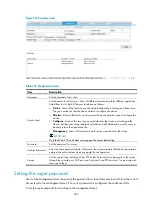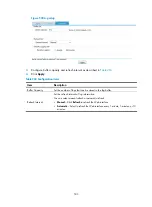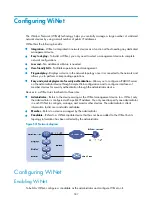
494
Configuring SNMP (lite version)
This chapter is only applicable to the MSR900/20-1X routers.
For information about configuring SNMP from the Web interface for the MSR20/30/50/93X/1000
routers, see "Configuring SNMP."
Overview
The Simple Network Management Protocol (SNMP) is an Internet standard protocol widely used for a
management station to access and operate the devices on a network, regardless of their vendors,
physical characteristics and interconnect technologies.
The SNMP framework comprises the following elements:
•
SNMP manager
—Works on a network management system (NMS) to monitor and manage the
SNMP-capable devices in the network.
•
SNMP agent
—Works on a managed device to receive and handle requests from the NMS, and
send traps to the NMS when some events, such as interface state change, occur.
HP supports SNMPv1, SNMPv2c, and SNMPv3. An NMS and an SNMP agent must use the same
SNMP version to communicate with each other.
•
SNMPv1
—Uses community names for authentication. To access an SNMP agent, an NMS must use
the same community name as set on the SNMP agent. If the community name used by the NMS is
different from the community name set on the agent, the NMS cannot establish an SNMP session to
access the agent or receive traps and notifications from the agent.
•
SNMPv2c
—Uses community names for authentication. SNMPv2c is compatible with SNMPv1, but
supports more operation modes, data types, and error codes.
•
SNMPv3
—Uses a user-based security model (USM) to secure SNMP communication. You can
configure authentication and privacy mechanisms to authenticate and encrypt SNMP packets for
integrity, authenticity, and confidentiality.
For more information about the SNMP protocol, see
HP MSR Router Series Network Management and
Monitoring Configuration Guide
.
Enabling the SNMP agent function
1.
Select
System Management
>
SNMP
from the navigation tree to enter the page as shown in
.
Содержание MSR SERIES
Страница 17: ...xv Documents 835 Websites 835 Conventions 836 Index 838 ...
Страница 20: ...3 Figure 3 Initial page of the Web interface ...
Страница 42: ...25 Figure 13 Firefox Web browser setting ...
Страница 59: ...42 Figure 27 Checking the basic service configuration ...
Страница 73: ...56 Figure 35 Sample interface statistics ...
Страница 156: ...139 Figure 139 Rebooting the 3G modem ...
Страница 168: ...151 Figure 152 Configuring Web server 2 ...
Страница 174: ...157 Figure 158 Configure the URL filtering function ...
Страница 187: ...170 Upon detecting the Land or Smurf attack on Ethernet 0 2 Router outputs an alarm log and drops the attack packet ...
Страница 242: ...225 Figure 233 Enabling the DHCP client on interface Ethernet 0 1 ...
Страница 247: ...230 Figure 236 The page for configuring an advanced IPv4 ACL ...
Страница 255: ...238 Figure 241 Advanced limit setting ...
Страница 298: ...281 e Click Apply 2 Configure Router B in the same way Router A is configured ...
Страница 354: ...337 Figure 339 Configuring a login control rule so Host B cannot access Router through the Web ...
Страница 400: ...383 Figure 387 Verifying the configuration ...
Страница 405: ...388 ...
Страница 523: ...506 Figure 530 Ping configuration page ...
Страница 538: ...521 a Click Device A on the topology diagram b Click Ethernet 0 2 on the panel diagram c Click Port Guard ...
Страница 744: ...727 Verifying the configuration In the case that the IP network is unavailable calls can be made over PSTN ...
Страница 775: ...758 Figure 785 Configuring a jump node ...
Страница 791: ...774 Figure 801 Configuring a jump node ...
















































